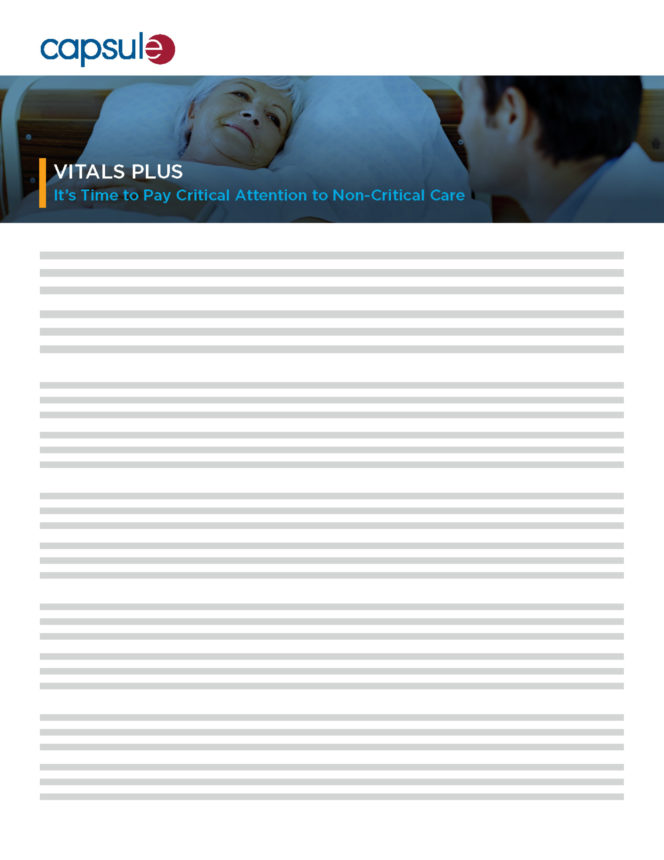In today’s non-critical care environment, workloads are tight, patient health is wide-ranging, and the nursing shortage is becoming more apparent. A recent report from the American Journal of Medical Quality predicts a shortage of registered nurses to spread across the country between 2009 and 2030.1
With a looming shortage of nurses and an increase in patient demand, nurses — and all healthcare providers — face the mounting challenge of doing more with less. Perhaps one of the most striking challenges that face providers today is the ability to streamline patient documentation and leverage timely, accurate patient data to make informed decisions at the point of care.
Treatment errors often result because providers don’t have real-time access to the patient data they need to make the right care decisions. To further compound the situation, the manual documentation of a patient’s vital signs creates needless rework for providers as they document and re-document patient data. It also can cause delays in patient treatment due to a lack of insight into a patient’s potential decline in health. Without real-time monitoring for non-critical patients, patient safety could be at risk.
To reduce medical errors and combat the inefficiencies of manual patient charting, here are three areas that will benefit from automated patient monitoring technology
3 Benefits of Automated Patient Monitoring Technology
1. Capturing Vitals
Taking patient vitals is one of the most critical components of quality healthcare. It can also be one of the most labor-intensive duties that fall upon healthcare providers. Utilizing automated technology that monitors patients and sends validated vital signs to electronic medical records (EMRs) right from the bedside, nurses have more time to focus on direct caregiving. This type of enhanced vitals monitoring provides significant benefits for both providers and patients, as charting time is reduced from hours to minutes.
Real-time data logging enables providers to build a comprehensive picture of the current patient’s health status and to detect when intervention and rapid response is needed to address a patient’s changing health condition.
2. Automating Documentation
Errors in medicine occur at a considerably higher rate than errors made in other industries.2 The principal sources of errors in point-of-care testing are failure to follow procedures, documentation, patient identification, operator identification, failure to perform quality control, and test performance.
By automating the documentation process of a patient’s vitals, providers reduce the risks associated with the mis-entry of patient information into the EHR, as well as the misidentification of patients. Automation efficiently delivers timely, electronic vital sign data and clinical observations, catalyzing actionable insights and giving clinicians more time with patients.
Human error in regard to transcription is eliminated, and data entry mistakes are virtually nonexistent. Additionally, better team collaboration occurs, even during shift changes. Providers can instantly access patient data for actionable insights and can easily match records to a patient and modify charts as needed. As healthcare facility staff sizes can grow to more than 11,000 individuals, digital processes help maintain compliance by ensuring credentials and certifications are standardized and up-to-date.3
3. Understanding Early Warning Signs
It is not uncommon for hospitalized patients to exhibit early warning signs before becoming weaker. The key to optimal outcomes is early recognition of these signs, followed by an appropriate and timely response from providers.
Recent discoveries created a way for clinicians to quantify what might be going wrong with a patient’s health in order to address health issues earlier in the care cycle. Enter the Early Warning Scoring System, or EWSS, which can encourage early intervention, timely transfer to a higher level of care and prevention of code conditions. Early detection of [unfavorable] changes in a patient’s vital signs can lead to a life-saving difference by alerting providers and allowing the healthcare team to intervene earlier, reducing risk.4
An EWSS registers subtle changes in vital signs and provides an immediate acuity score based on a patient’s custom-configured algorithm. Automated patient monitoring technology that incorporates an EWSS eliminates manual calculations while reducing guesswork and lag time, helping teams respond quickly and appropriately when situations are dire.
RELATED READING: Improve Sepsis Outcomes: Incorporate An Early Warning Scoring System Into Bedside Care
Paying Critical Attention to Non-Critical Care
Through automated technology, Capsule addresses the challenges that providers face when it comes to patient monitoring. By simplifying key workflows of the documentation process, charting time can be reduced, and transcription errors can be prevented along with data gaps and lags in patient care.
Automated technology can enhance clinical surveillance, help reduce false positive alarms and provide real-time access to streaming patient data. Capsule Technologies’ platform drives patient safety, improves staff communication, and enhances both the clinician and patient experience.
